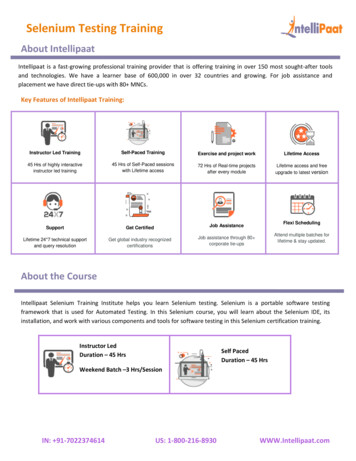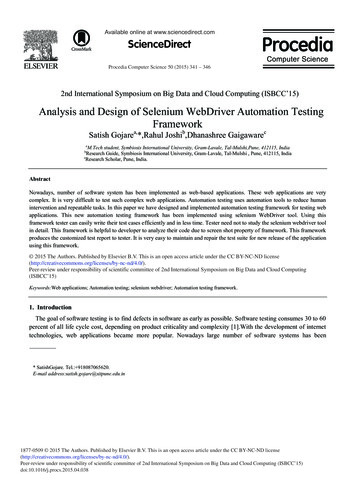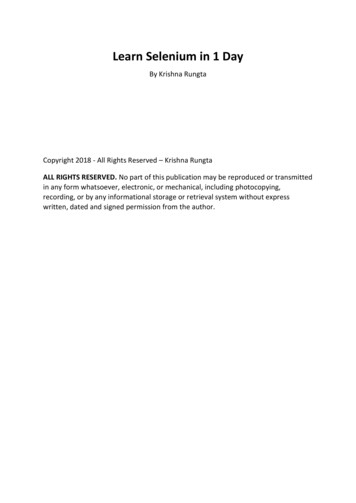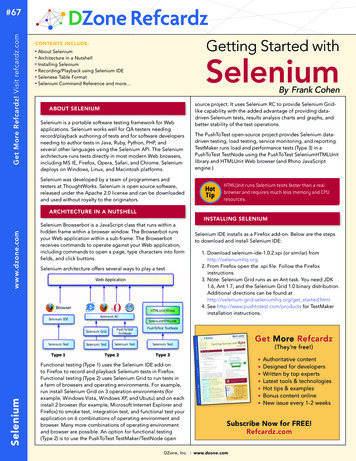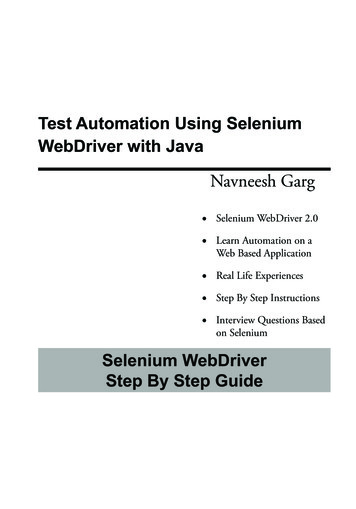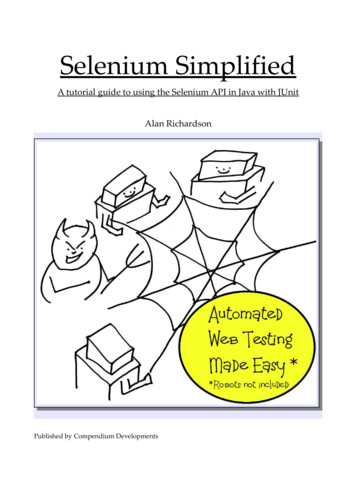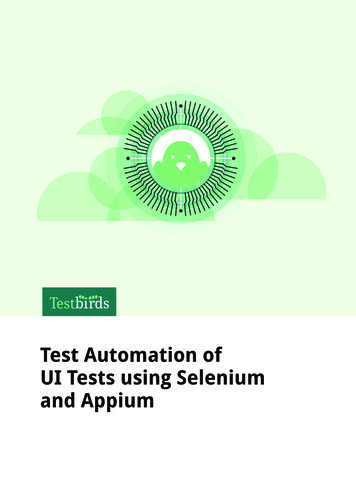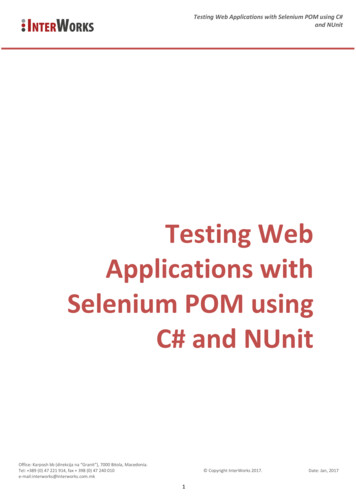
Transcription
Testing Web Applications with Selenium POM using C#and NUnitTesting WebApplications withSelenium POM usingC# and NUnitOffice: Karposh bb (direkcija na “Granit”), 7000 Bitola, Macedonia.Tel: 389 (0) 47 221 914, fax 398 (0) 47 240 010e-mail:interworks@interworks.com.mk Copyright InterWorks 2017.1Date: Jan, 2017
Testing Web Applications with Selenium POM using C#and NUnitCONTENTS1INTRODUCTION . 31.11.21.31.42WHAT IS SELENIUM? . 3SELENIUM IDE . 3SELENIUM WEB DRIVER . 3SELENIUM GRID . 3BUILD SELENIUM TESTS USING NUNIT FRAMEWORK . TTING UP THE PROJECT . 5BUILDING THE SELENIUM CODE . 7Setting up the main class. 8The PageActions class . 10The BasicMethods class . 11The Validations class . 11PAGE OBJECT MODEL (POM) . 12NUNIT TESTING FRAMEWORK . 13Assertions . 13Constraints . 14Attributes. 14Office: Karposh bb (direkcija na “Granit”), 7000 Bitola, Macedonia.Tel: 389 (0) 47 221 914, fax 398 (0) 47 240 010e-mail:interworks@interworks.com.mk Copyright InterWorks 2017.2Date: Jan, 2017
Testing Web Applications with Selenium POM using C#and NUnitINTRODUCTION1.1 What is Selenium?Selenium is an open source suite that is used for web applications test automation. It allowsrecording or scripting automated test flows. It uses a test domain-specific language Selenese. Testscan be written in a number of popular programming languages, including C#, Java, PHP, Python,Ruby, Groovy and Scala. Automation is supported for multiple web browsers as well multipleplatforms.The Selenium suite consists of the following components: Selenium IDE, Selenium RC, Web Driverand Selenium Grid. The Selenium RC and Web driver have been merged into a single frameworkSelenium 2, which is widely accepted and used.1.2 Selenium IDESelenium Integrated Development Environment (IDE) is the simplest framework in the Seleniumsuite and is the easiest one to learn. It is a Firefox plugin that can be installed and used forrecording the flows inside web application. Because of its simplicity, it is used as prototyping tool.1.3 Selenium Web DriverSelenium WebDriver is used for creation of robust, browser-based regression automation suitesand tests that can be run in different browsers by leveraging specific browser drivers for Chrome,Firefox and Internet Explorer. At highest level, Selenium WebDriver, simply, accepts programmedcommands, sends them to a browser and interacts with the HTML elements on the page.However, before driver can interact with the element, it need to be located (find) in the page. TheWebDriver’s method findElement() is used for that purpose. The driver can find elements on theweb page using several types of locators: By IdBy Class NameBy Tag NameBy NameBy Link TextBy CSSBy XPathThese locators will search the web page’s HTML and find particular element(s) based on thesupplied Id, XPath, ClassName etc.After driver, finds element, it is returned as WebElement object. WebElement objects, exposemethods that simulate “human” interaction with the page. Methods that often used are: click(),sendKeys(), submit(), getText(), etc.1.4 Selenium GridSelenium Grid is a server that allows to run tests on different machines against different browsersin parallel. The server acts as a hub, while all browser instances contact that hub.Running the tests with Selenium Grid mainly gives the following advantages: Running the tests against different browsers, operating systems and machines at the same time.This will ensure that the application is fully compatible with range of browser/OS combinationsOffice: Karposh bb (direkcija na “Granit”), 7000 Bitola, Macedonia.Tel: 389 (0) 47 221 914, fax 398 (0) 47 240 010e-mail:interworks@interworks.com.mk Copyright InterWorks 2017.3Date: Jan, 2017
Testing Web Applications with Selenium POM using C#and NUnit Saves time in the execution of test suitesFigure 1. Selenium Grid uses a hub-node concept where you only run the test on a single machinecalled a hub, but the execution will be done by different machines called nodesOffice: Karposh bb (direkcija na “Granit”), 7000 Bitola, Macedonia.Tel: 389 (0) 47 221 914, fax 398 (0) 47 240 010e-mail:interworks@interworks.com.mk Copyright InterWorks 2017.4Date: Jan, 2017
Testing Web Applications with Selenium POM using C#and NUnitBUILD SELENIUM TESTS USING NUNIT FRAMEWORKNote: In this tutorial we will build an example for Smoke Test on LinkedIn web application. The scenariowill cover user log in, navigation to the edit profile page, elements validation on the profile page and logout.1.5 Setting up the projectMicrosoft Visual Studio, preferably the latest version, is required for building and running this test project.First of all, the NUnit should be installed in Visual Studio. For that purpose, navigate to Tools - Extensionsand Updates and search for NUnit. Install the “NUnit 3 Test Adapter” and “Nunit Templates for VisualStudio”. After installing these extensions, you will be asked to restart the Visual Studio in order to makethese extensions available for use.Figure 2. Installing NUnit in Microsoft Visual StudioNext, you need to create the project. Click File- New- Project. On the left side of the pop up windowchoose Test and from the templates choose “NUnit 3 Unit Test Project”. Give a name to your project andlocation to be saved to.Office: Karposh bb (direkcija na “Granit”), 7000 Bitola, Macedonia.Tel: 389 (0) 47 221 914, fax 398 (0) 47 240 010e-mail:interworks@interworks.com.mk Copyright InterWorks 2017.5Date: Jan, 2017
Testing Web Applications with Selenium POM using C#and NUnitFigure 3. Create test projectIn the newly created test Class, you will notice the [TextFixture] and [Test] annotations. Beside these, theannotations [SetUp] and [TearDown] are widely used in NUnit in order to mark some methods that areused as test case execution lifecycle callbacks.Each test case execution includes the following phases:1.[SetUp] – The method under this annotation opens the browser. It executes before every testcase2. [Test] – Every test case should have this annotation in order to be executed3. [TearDown] – The method under this annotation executes after each test case and it usuallycloses the browser, makes some changes in DB etc.Office: Karposh bb (direkcija na “Granit”), 7000 Bitola, Macedonia.Tel: 389 (0) 47 221 914, fax 398 (0) 47 240 010e-mail:interworks@interworks.com.mk Copyright InterWorks 2017.6Date: Jan, 2017
Testing Web Applications with Selenium POM using C#and NUnit1.6 Building the Selenium CodeThe final version of the automated Selenium project will consist of the following classes: LinkedinTests,PageActions, BasicMethods, Validations and PageObjects.The separation of code when writing automated tests is a goodpractice because it provides easier and quicker updates of tests. In thisexample, all page specific methods are declared in one class(PageActions), all validations are defined in other class (Validations).The class BasicMethods contains the most common user actions thatare not page specific. Finally, in the class LinkedinTests, all methodsare reused and combined in several specific test scenarios.The class PageObjects contains all hard-coded page elements values(names, ids etc.). So, if any change is made to the page HTML, updatesneed to be done only in the class that corresponds to that page,without modification in all tests where that page is used.Office: Karposh bb (direkcija na “Granit”), 7000 Bitola, Macedonia.Tel: 389 (0) 47 221 914, fax 398 (0) 47 240 010e-mail:interworks@interworks.com.mk Copyright InterWorks 2017.7Date: Jan, 2017
Testing Web Applications with Selenium POM using C#and NUnitFigure 5. Class Model1.6.1 Setting up the main classThe main class LinkedinTests is the main entry point in the testing fixture and contains SetUp, TearDown,SmokeTest and RegressionTest nium;OpenQA.Selenium.Chrome;System;namespace LinkedinTest{[TestFixture]public class LinkedinTests{static IWebDriver driver;PageActions pageActions new PageActions();Validations validations new Validations();public String email "testaccount@gmail.com"; // Replace with valid registered email on linkedinpublic String password "pass"; // Replace with valid password used whenregisteringpublic String username "JohnWack"; // Replace with valid username usedwhen registeringpublic String fullName "John Wack";public String locality "Macedonia";public String linkedinURL "https://www.linkedin.com/";[SetUp]public void SetUp(){driver new lyWait(TimeSpan.FromSeconds(30));}[Test]public void SmokeTest(){pageActions.navigateToLinkedin(driver, linkedinURL);pageActions.Login(driver, email, password);pageActions.navigateThroughMenu(driver, , extInElement(driver, PageObjects.fullNameElement, , PageObjects.localityElement, e("Ignore a test")]Office: Karposh bb (direkcija na “Granit”), 7000 Bitola, Macedonia.Tel: 389 (0) 47 221 914, fax 398 (0) 47 240 010e-mail:interworks@interworks.com.mk Copyright InterWorks 2017.8Date: Jan, 2017
Testing Web Applications with Selenium POM using C#and NUnit44.45.46.47.48.49.50.51.52.53.54.55. }public void RegressionTest(){}[TearDown]public void TearDown(){driver.Quit();}}In the SetUp method, the driver is initialized as new ChromeDriver. In order to use the ChromeDriver, itmust be installed first and added as a reference in the project. For that purpose, click on References - Manage NuGet Packages. Search for “WebDriver” and “Selenium.WebDriver.ChromeDriver”. Install thesepackages to the project.Figure 6: Installing WebDriverIn order Chrome driver to be used, add reference: using OpenQA.Selenium.Chrome; and with thissetup, the Chrome browser will be opened at the beginning of each test. Please note that after driverinitialization, is added wait period of 30 seconds in order to anticipate some delay if the browser can’topen immediately.The method SmokeTest method is calling other methods from classes PageActions and Validations. Sincethe used methods are created to be re-usable, specific details are sent as parameters. For example toLogin, email and password used in the test, are sent as parameters to the pageActions.Login method.Please also note, that public variables from PageObjects class, for examplePageObjects.fullNameElement, are sent as parameters. The fullNameElement is declared as globalvariable in class PageObjects, and defines path to particular page object.Office: Karposh bb (direkcija na “Granit”), 7000 Bitola, Macedonia.Tel: 389 (0) 47 221 914, fax 398 (0) 47 240 010e-mail:interworks@interworks.com.mk Copyright InterWorks 2017.9Date: Jan, 2017
Testing Web Applications with Selenium POM using C#and NUnitSince the scope of this tutorial is smoke test, only SmokeTest method is defined. The execution of themethod RegressionTest is skipped, by annotating it with the “[Ignore("Ignore a test")]”.Finally, the TearDown method just closes the browser at the end of each test.1.6.2 The PageActions classThe PageActions class, defines methods that “mimics” user interactions with the web site under test. Forexample, method navigateToLinkedin simulates navigating to LinkedIn home page, while Loginsimulates logging into LinkedIn, navigating to home page and validating existence of particular elements(News Feed). This class can be extended with methods for additional user actions, like ConnectToFriend,EndorseFriend, LikePost etc.1.2.3.4.5.6.7.8.9.10.11.12.13.14.15.16.using OpenQA.Selenium;using OpenQA.Selenium.Interactions;using System;namespace LinkedinTest.Tests1{public class PageActions{BasicMethods basicMethod new BasicMethods();Validations validations new Validations();public void navigateToLinkedin(IWebDriver driver, String );validations.validateScreenByUrl(driver, driver, 4.25.26.}public void Login(IWebDriver driver, String email, String password){basicMethod.clickElement(driver, driver, PageObjects.loginEmailInput, email);basicMethod.clickElement(driver, river, PageObjects.loginPassInput, password);basicMethod.clickElement(driver, PageObjects.loginButton);// Wait up to 30s for the user to login and to be redirected to dateElementIsPresent(driver, }36.37.38.}public void navigateThroughMenu(IWebDriver driver, By menu, By submenu){Actions builder new er.FindElement(submenu)).Click().Perform();public void Logout(IWebDriver driver)Office: Karposh bb (direkcija na “Granit”), 7000 Bitola, Macedonia.Tel: 389 (0) 47 221 914, fax 398 (0) 47 240 010e-mail:interworks@interworks.com.mk Copyright InterWorks 2017.10Date: Jan, 2017
Testing Web Applications with Selenium POM using C#and NUnit39.40.41.{Actions builder new ts.logoutButton)).Click().Perform();43.}44.45.}46. }1.6.3 The BasicMethods classThe BasicMethods class, simulates simple user actions like clicking a button or typing text in a text 17.18.using OpenQA.Selenium;namespace LinkedinTest.Tests1{public class BasicMethods{public void clickElement(IWebDriver driver, By ic void sendKeys(IWebDriver driver, By element, string }}The method clickElement finds particular element, that is passed as parameter, and “click” on it. Similar,method sendKeys finds the element and then sends string of characters that are also passed asparameter.1.6.4 The Validations classThe Validations class implements necessary test validations. In this example, Validation class implementsthree generic validations on particular elements, which are passed as parameters. The methodvalidateScreenByUrl validates page on which the user is navigated, validateElementIsPresentvalidates if particular element is present on the page and validateTextInElement validates text that isdisplayed in particular element.1.2.3.4.5.6.7.8.9.using NUnit.Framework;using OpenQA.Selenium;using System;namespace LinkedinTest.Tests1{public class Validations{public void validateScreenByUrl(IWebDriver driver, String screenUrl)Office: Karposh bb (direkcija na “Granit”), 7000 Bitola, Macedonia.Tel: 389 (0) 47 221 914, fax 398 (0) 47 240 010e-mail:interworks@interworks.com.mk Copyright InterWorks 2017.11Date: Jan, 2017
Testing Web Applications with Selenium POM using C#and NUnit10.11.12.13.14.15.16.17.18.19.20.21.{String currentURL rl));}public void validateElementIsPresent(IWebDriver driver, By element){IWebElement findElement ent.Displayed);}public void validateTextInElement(IWebDriver driver, By element, String text)22.23.24.25.26.27. }{String findElement dElement.Equals(text));}}Validations are implemented using the NUnits Assert class. For example, theAssert.IsTrue(currentURL.Equals(screenUrl)); validates that value of variable currentURLis same with value screenUrl. If these two match, the condition will return true, which is exactly whatAssert.IsTrue expects. In other words, the assertion will pass.1.7 Page Object Model (POM)In the PageObjects class in this example, implements Page Object Model (POM) paradigm forimplementing web automated tests using Selenium. In this class are defined global variables for webelements that will be further used in all tests. The purpose of this class, is to have the web elementsdefined in one single place, so if any web element is changed in the future, the tests will be easily tomaintain. Also, with object declaration in one class, every object will be reusable around the entire project.As good practice, for easy test maintenance, web objects on particular page can be separated in “groups”.Also depending on complexity of implemented tests, test project can implement multiple PageObjectsclasses – one per each page.1. using OpenQA.Selenium;2.3. namespace LinkedinTest4. {5.public static class PageObjects6.{7.// Login screen objects8.public static By loginEmailInput By.Id("login-email");9.public static By loginPassInput By.Id("login-password");10.public static By loginButton By.Id("login-submit");11.public static By forgotPassLink By.LinkText("Forgot password?");12.13.// Home screen objects14.public static By newsFeedElement By.Id("ozfeed");15.16.// Profile screen objects17.public static By fullNameElement By.ClassName("full-name");18.public static By localityElement By.ClassName("locality");19.20.// Menu objectsOffice: Karposh bb (direkcija na “Granit”), 7000 Bitola, Macedonia.Tel: 389 (0) 47 221 914, fax 398 (0) 47 240 010e-mail:interworks@interworks.com.mk Copyright InterWorks 2017.12Date: Jan, 2017
Testing Web Applications with Selenium POM using C#and NUnit21.22.23.24.25.26.27.public static By ProfileLinkMenu By.XPath(".//*[@id 'main-sitenav']/ul/li[2]/a");public static By editProfileLink By.XPath(".//*[@id 'profile-subnav']/li[1]/a");public static By addPhotoElement By.ClassName("edit-photo-content");public static By navProfilePhoto By.ClassName("nav-profile-photo");public static By logoutButton By.XPath(".//*[@id n[3]/a");}}Benefits of using POM paradigm, can be summarized as: The Page Object Model helps make code more readable, maintainable and reusable.It is a design pattern to create Object Repository for web UI elements.The names of the variables and methods should be given as per the task they areperforming. For example loginEmailInput – Web UI element ; Login – method Page Object Pattern says operations and flows in the UI should be separated from verification.This concept makes our code cleaner and easy to understand. The object repository is independent of test cases, so we can re-use the same object repository,and once a change is made to web element only one change is code is needed. This is one of thegreatest benefits of the pattern.1.8 NUnit testing frameworkNUnit is an open source unit testing framework for Microsoft .NET. It serves the same purpose as JUnitdoes in the Java world, and is one of the many programs in the xUnit family. The frameworks includesdifferent assertions, constraints and attributes.1.8.1 AssertionsAssertions are central in automated tests, since those check if some test output parameter has expectedvalue. In a case when assertion fails, an error is reported, that can be further propagated in automatedtest reports.NUnit offers many assertions, as methods, such as: Equality Asserts, Identity Asserts, Condition Asserts,Comparison Asserts, Type Asserts, Exception Asserts, Utility Methods, String Asserts, Collection Asserts,File Asserts, and Directory Asserts.The Equality Assert and Condition Assert are most commonly used. Below are some examples of thesetype of assertions: Assert.AreEqual(int expected, int actual ); // type can be decimal, float, double, objectetc.Assert.AreEqual(int expected, int actual, string message );Assert.AreNotEqual(int expected, int actual ); // type can be decimal, float, double,object etc.Assert.AreNotEqual(int expected, int actual, string message );Assert.IsTrue(bool condition );Office: Karposh bb (direkcija na “Granit”), 7000 Bitola, Macedonia.Tel: 389 (0) 47 221 914, fax 398 (0) 47 240 010e-mail:interworks@interworks.com.mk Copyright InterWorks 2017.13Date: Jan, 2017
Testing Web Applications with Selenium POM using C#and NUnit Assert.IsTrue(bool condition, string message );Assert.IsFalse(bool condition);Assert.IsFalse(bool condition, string message );Assert.IsNull(object anObject );Assert.IsNull(object anObject, string message );Assert.IsEmpty(string aString );Assert.IsEmpty(string aString, string message );Assert.IsNotEmpty(string aString );Assert.IsNotEmpty(string aString, string message );1.8.2 ConstraintsThe constraint-based Assert model uses a single method of the Assert class for all assertions. The logicnecessary to carry out each assertion is embedded in the constraint object passed as the secondparameter to that method.An example of using constraint model is assertion:1.Assert.That( myString, Is.EqualTo("Hello") );The second argument in this assertion uses one of NUnit's syntax helpers to create an EqualConstraint. Thesame assertion could also be made in this form:1. Assert.That( myString, new EqualConstraint("Hello") );Using this model, all assertions are made using one of the forms of the Assert.That() method, which can beoverloaded.1.8.3 AttributesNUnit has custom attributes such as: Setup, Test, Teardown, TestFixture, Ignore, Category, Description,Exception etc. The Setup, Test, Teardown, TestFixture and Ignore attributes were already used in theexample above and their purpose was already explained.The Category attribute provides an alternative to suites for dealing with groups of tests. Individual tests orfixtures can be identified as belonging to a particular category. When this attribute is used, only particulartests that belongs to particular Category will be run.1.2.3.4.5.6.7.8.9.10.11.12.13.namespace NUnit.Tests{using System;using NUnit.Framework;[TestFixture]public class SuccessTests{[Test][Category("Long")]public void VeryLongTest(){ /* . */ }}Office: Karposh bb (direkcija na “Granit”), 7000 Bitola, Macedonia.Tel: 389 (0) 47 221 914, fax 398 (0) 47 240 010e-mail:interworks@interworks.com.mk Copyright InterWorks 2017.14Date: Jan, 2017
Testing Web Applications with Selenium POM using C#and NUnitThe Description attribute is used to apply descriptive text to a Test, TestFixture or Assembly. The textappears in the XML output file with test results and is shown in the Test Properties ly: Description("Assembly description here")]namespace NUnit.Tests{using System;using NUnit.Framework;[TestFixture, Description("Fixture description here")]public class SomeTests{[Test, Description("Test description here")]public void OneTest(){ /* . */ }}}The Exception attribute specifies if particular test is expected to throw an exception. The attribute givesoption to specify the exact type of expected exception, but also to include the exact text of the exceptionor the custom error message. The use of this attribute helps in testing negative scenarios.1. [ExpectedException( typeof( ArgumentException ), ExpectedMessage "expected message" )]For more details on NUnit framework please refer to: http://www.nunit.org/Office: Karposh bb (direkcija na “Granit”), 7000 Bitola, Macedonia.Tel: 389 (0) 47 221 914, fax 398 (0) 47 240 010e-mail:interworks@interworks.com.mk Copyright InterWorks 2017.15Date: Jan, 2017
1.2 Selenium IDE Selenium Integrated Development Environment (IDE) is the simplest framework in the Selenium suite and is the easiest one to learn. It is a Firefox plugin that can be installed and used for recording the flows inside web application. Because of its simplicity, it is used as p
